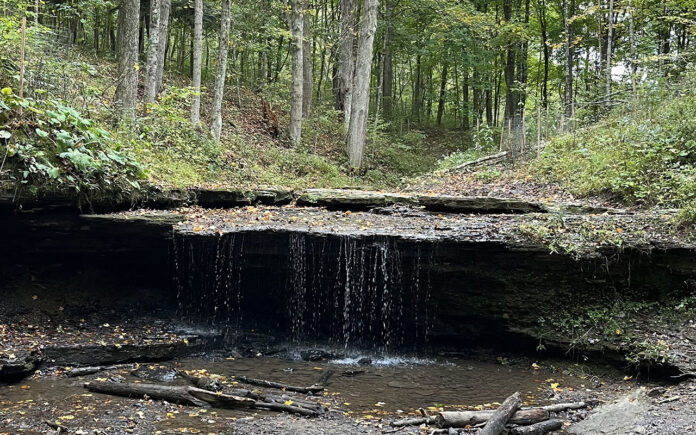
Most people choose a hobby because they enjoy the process. It’s not like that for me with restoring furniture. I despise the process, but I love the final product.
Above my fireplace is a large, round mirror framed with the most beautiful wood tones. It wasn’t always a thing of beauty. In a past life, it was a lacquered orange color. Then the orange lacquer was painted over with a cotton candy shade of pink.
When I grabbed a hold of it, I was determined to find the natural wood under layers of paint. After hours of work spread out over a few days, I took a break to go hiking with my daughter and our energetic dog. Fresh air and fall foliage was an invigorating combination.
Settlers Cabin
The park we went to is situated about 15 miles from downtown Pittsburgh, in between downtown and the airport. Settlers Cabin Park consists of 1,610 acres in Allegheny County.
I soon learned that the park is in the middle of a restoration process. Instead of peeling back layers of paint on wood, a different process re-establishes a native forest.
The six nations of the Iroquois Confederacy lived in the area long before European settlers but left little more than a trace. The landscape changed dramatically after the French and Indian War. Europeans changed the land from a forest into agricultural fields. In the 20th century, farmers sold the mineral rights to the land.
The rock layers of the area were classified by geologists as the Monongahela and Casselman formations. The Monongahela group has layers of limestone, shale and sandstone. It also includes a very thick layer of coal known as the Pittsburgh coal seam. This layer was important to the economy of the area as it was extensively mined.
Another important component of the Monongahela group is that the sandstone and shale layers contain calcareous materials, affecting the calcium content and pH of the soil. Typically, plants do well in soil with a pH of 5.0 to 6.5. In multiple areas of Settlers Creek, the soil pH is higher at 6.0 to 7.0.
The natural diversity of plant species in Pennsylvania includes many plants that thrive on acidic and calcareous soil. The plant and animal life of the area demonstrate that the park is in the middle ground between the midwest and the Appalachian Mountains.
The low rolling hills of the area were formed by gradual erosion along streams. This is in contrast to the glaciated areas to the north and the tectonic plate upheaval in the Appalachian Mountains.
Restoration
The park acreage was purchased by the county in 1971. A portion of the park was later transitioned into the Pittsburgh Botanical Garden. When the county purchased the land, active wells and exposed oil and gas lines were closed. Over 75% of the park at one point was cleared for agricultural use or coal mining.
The scars from mining and the ecological damage from clearing land created a challenge. They were not the only challenge to restoring the forest. Invasive species continue to threaten plant life, both young and mature.
Foraging deer in the park also have a large impact on the plant species. The original predator of deer was wolves. Now that there are no longer wolves in the region, the deer population continues to swell.
Several notable and rare plant species have been identified in the park. James Sedge has been found in the park. It forms tufts of grass and the seed pods are balloon shaped. Goldenseal is also growing in the park. It has medicinal uses and can be made into tea. It has been used for decades to treat respiratory tract infections and hay fever.
Ramps are another edible plant found within park boundaries. Ramps have a rich cultural tie to Appalachian heritage. In recent years, overharvesting of ramps has threatened the species. They are only visible in May and June. The park only has a small population and harvesting is not sustainable.
Visitors are encouraged to take only photographs and leave only footprints. The day we visited was after a few days of heavy rain. While we wanted to hike for miles, the mud on the trails limited our distance.
Waterfall
We couldn’t leave the park without visiting the waterfall. The waterfall trail is only half a mile but travels down into a valley. It is an out and back; the return trip is somewhat steep and can be strenuous. The water-darkened layers of sandstone in the streambed created a picturesque setting.
Falling leaves and streams of trickling water invited me into a scene of autumn bliss. Squirrels were busy gathering acorns for winter. Evidence of the reforestation effort was all around us on our walk. Several plant species were protected by wire mesh from foraging deer. We noticed a sweet buckeye sapling was one of the protected species.
The park was stunning in the fall. It is hard to imagine the changes that took place on the land. Many challenges continue to threaten the process to bring back the forest, but from our perspective, the progress is very encouraging.
My furniture project was waiting for me when I returned home. I had more layers to strip away while the park continually adds back. The end goal is the same, restoration of natural beauty.












